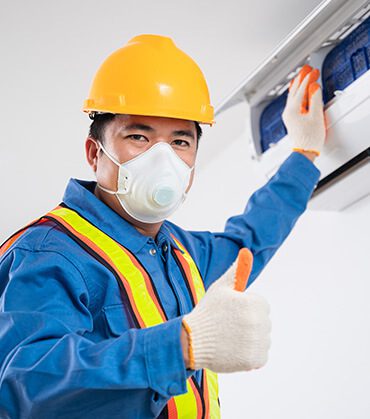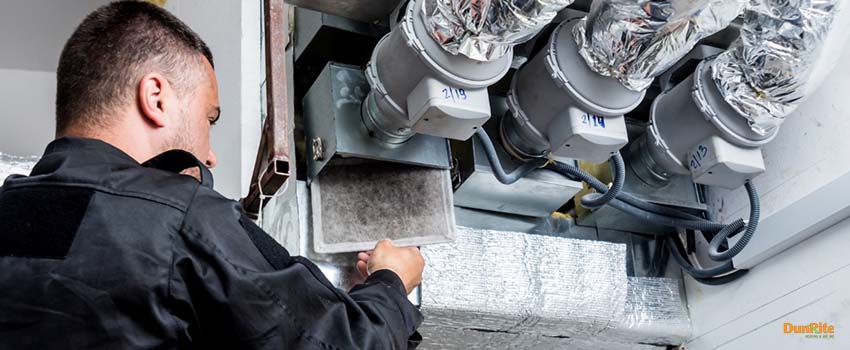The difference between HVAC units and air conditioners is a common area of confusion for many homeowners. Although the two are distinct, people are often confused as to what distinguishes one from the other.
The confusion is further exacerbated by the fact that many contractors and builders use HVAC and air conditioners interchangeably. This blurs the distinction between the two systems, but a short HVAC for dummies should help clear things up.
What Is HVAC?
HVAC is a system regulating the humidity, temperature, and air quality in an indoor space, including homes, office spaces, commercial spaces, and, yes, even vehicles. An HVAC aims to maintain acceptable indoor air quality and thermal comfort. Its design is based on heat transfer, fluid mechanics, and thermodynamics, but variations to the system’s framework are sometimes added.
What Does HVAC Stand For?
Apart from what is HVAC, the above is the other question many people are interested in finding the answer to. HVAC actually means heat, ventilation, and air conditioning. The acronym describes the three different functions of the system as applied in many modern homes and buildings.
Typically, the HVAC system comprises the furnace, the air conditioning system, and vents or ducts that can help release moisture. While all HVAC units can have an air conditioner, not all ACs come with an HVAC network.
Types of HVAC Systems
From a broad perspective, an HVAC can be classified as either ducted or ductless. The former uses a central unit to push air through a series of ducts. The latter, meanwhile, has no air ducts and instead uses alternate methods to distribute air.
In a more specific description, an HVAC system can be categorized as follows:
1. Split System
Split systems for heating and cooling are the most popular types of HVAC systems. These are usually found in residential structures and consist of two distinct components, one for heating and the other for cooling. They use a traditional thermostat to control the temperature throughout a given structure.
Split systems typically have the heating unit in the basement, utility closet, or indoor storage area. The heater runs on gas and uses a fan or evaporator to heat a building’s ductwork. On the other hand, the cooling system is located outside but is connected to the ductwork through a series of tubes. It uses a refrigerant, coils, and compressors to produce cool air while a fan blows hot air away.
2. Hybrid Split System
This HVAC system uses a combination of heating and cooling units but is not powered by gas. Relying on electricity, heating is significantly slower and less efficient though. Nevertheless, it gives homeowners greater control over their energy consumption.
3. Zoned System
HVAC zoning systems allow users to control the temperature in different rooms and areas of a building or home. Zone-ducted HVAC systems can be installed in various ways, but the main consideration is how large the building is. In general, however, this type of HVAC requires that you have at least two heating and cooling units.
4. Packaged Heating and Cooling System
This is an HVAC system known for its small or compact size. It is often found in homes that don’t have enough storage space, including roofs, basements, attics, and corner areas close to the foundation. Both its heating and cooling components are usually stored in a single unit. Connecting the system to a building’s supply and return ducts can be made through a hole in the wall.
5. Hydronic Heating
Unlike other HVAC systems, this uses liquid rather than air to produce heat. Its boiler distributes heat through a network of pipes located underneath the floors. The target area gets heated once the liquid heat reaches a radiator, a baseboard heater, or other similar devices.
6. Ductless Mini-Split System
These are ductless HVAC systems designed for single rooms and are common fixtures in hotels, offices, and multi-family homes. Also known as mini-splits, these systems include an outdoor compressor and condenser, a refrigerant, a thermostat, a heat pump, cables, and an indoor air-handling unit.
7. Portable Heat Pump System
Portable heat pumps pull in air from the outside, run this through a condenser coil, and distribute warm air throughout a room when the system is switched to heating mode. Since the unit has a reversing valve that allows you to switch between cooling and heating capabilities, a portable heat pump system is an excellent choice for people living in different climates.
8. Portable Spot Cooler System
These portable cooling systems can be placed anywhere as long as there is available electric power. However, finding a location for its exhaust system can be difficult.
In any case, a spot cooler system works on cooling the air and pumping out any warm air through a flexible exhaust tube. The tube can be extended but must exit through a door or window to keep warm air from entering the space.
How Long Do HVAC Systems Last
Many residential HVAC systems normally last between 10-25 years. However, this will depend on several factors, such as the frequency of HVAC tune-ups, local climate, temperature level preferences, and the current setup of your HVAC unit, i.e., if it includes a boiler or a furnace.
Additionally, the type of air conditioners and heaters you have will also play a significant role in the longevity of your HVAC systems. For example, a window air conditioner can last about ten years. A furnace, meanwhile, can work for 18 years, with steam boilers capable of serving you a bit longer at 20 years.
Key Takeaway
To many people, air conditioning units and HVAC systems are the same. This is understandable since most manufacturers often use the two interchangeably. Additionally, not too many take the time to find out the difference since the main and immediate goal of getting an HVAC unit is to experience the comfort that it brings.
Briefly, air conditioners are often just one component of HVAC systems. The latter has a wider coverage as it also comprises ventilation and heating units. When these different components of an HVAC need to be repaired, this can be done separately. This is because many repair experts have their respective specializations even as they work for one professional company.
For all your heating and cooling repair and maintenance needs, your best choice is DunRite Heating & Air, Inc.
Whether it’s a noisy air conditioning unit or a malfunctioning heater, trust them all to the experts at DunRite Heating & Air, Inc.
As a family-owned company, we know how it feels when your AC does not produce cool air and the kids have difficulty dealing with the heat. If this happens to you often, contact us, and our HVAC San Jose professionals will work on resolving the problem right away. Call us.



